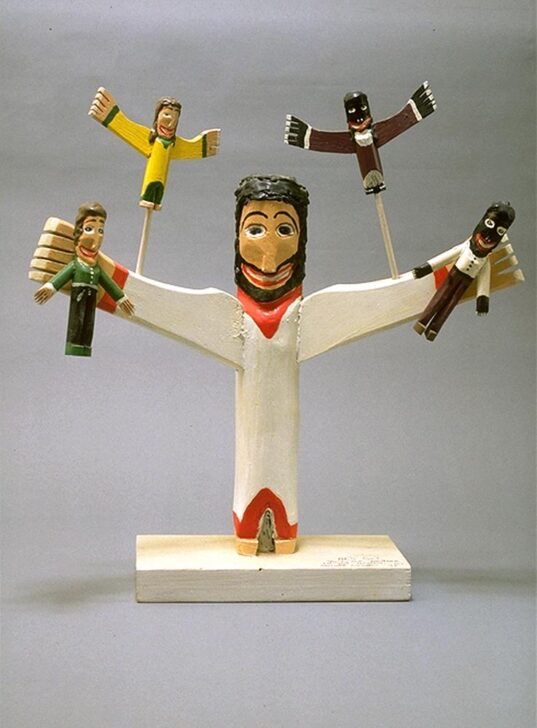He’s Got You and Me Brother
Ronald E. Cooper

Description
Ronald E. Cooper
United States, born 1931
He’s Got You and Me Brother
1992
Carved and painted wood
Gift of the Daniel and Harriet Fusfeld Folk Art Collection, 2002/1.213
Earnest Patton
United States, born 1935
Man in Business Suit
1970–92
Carved and painted wood
Gift of the Daniel and Harriet Fusfeld Folk Art Collection, 2002/1.212
Sherman Lambdin
United States, born 1948
Red Devil Bird
1970–91
Painted wood twig
Gift of the Daniel and Harriet Fusfeld Folk Art Collection, 2002/1.211
Cooper, Lambdin, and Patton are all professional Kentucky “whittlers,” or folk carvers. Southern carvers often include religious references in their works. Here, Cooper’s figure refers to the lyrics of a traditional African American spiritual, while Patton’s cane snake is a common nineteenth-century folk art symbol that has survived to contemporary times. Carved cane snakes were an African art tradition carried to the American South by enslaved West Africans, for whom snake imagery held spiritual significance.
(Out of the Ordinary, 2010)
Born near Flemingsburg, Kentucky in 1931, Ronald Cooper did not begin to produce art until 1984 when a serious automobile accident left him disabled. Shortly after the accident, Ronald Cooper and his wife Jessie left Marion, Ohio where Ronald worked on an assembly line. They returned to Flemingsburg, Kentucky, where they still live today.
Cooper began whittling animals in the mountain craft style, then moved on to produce larger, more intricate wooden sculptures. Both Coopers are artists and they often collaborate on their works. Jessie Cooper explains: "We each do our separate thing. But if I need something carved, he carves, and I sometimes paint on his."
Inspired by Ronald Cooper’s fundamentalist Christian beliefs, this work depicts the popular Biblical image of Christ holding people in his hands, sheltering them from evil. The angels affixed to Christ’s arms on wooden pegs also watch over Christ’s people as an extension of Christ’s own vigilance. This image serves to remind people of Christ’s love, understanding, and constant presence in their lives.
Lindsay Meehan
Modern and Contemporary Art Intern
2002
Usage Rights:
If you are interested in using an image for a publication, please visit https://umma.umich.edu/request-image/ for more information and to fill out the online Image Rights and Reproductions Request Form.